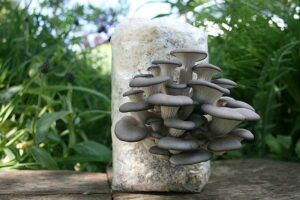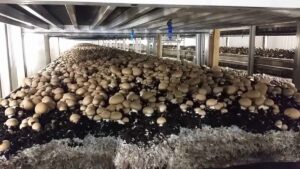Notable Elements
Variety of Options: Explore a range of mushroom varieties perfect for home cultivation, including Oyster, Shiitake, White Button, Lion’s Mane, and more.
Easy to Grow: Many of these mushrooms, especially Oyster and Shiitake, are beginner-friendly and can be grown easily with home-growing kits.
Rich Flavors: Enjoy diverse flavors and textures, from the delicate taste of Enoki to the meaty richness of Portobello mushrooms.
Health Benefits: Discover varieties like Lion’s Mane and Reishi, known for their potential health and cognitive benefits.
Optimal Growing Conditions: Learn about the specific temperature, humidity, light, and substrate requirements for successful mushroom cultivation.
Home-Grown Freshness: Experience the joy and satisfaction of harvesting your own fresh, flavorful mushrooms right at home.
Legal and Safe Cultivation: Understand the importance of adhering to legal regulations and maintaining cleanliness for a successful and safe growing experience.
Holistic Hobby: Engage in mushroom growing as a rewarding hobby that brings culinary diversity and the joy of gardening indoors.
Introduction
If you’re a fan of mushrooms and have always wanted to try growing them, so home-growing kits are an excellent starting point. Growing mushrooms at home can be an exciting and rewarding experience, allowing you to harvest fresh and flavorful fungi. For cultivation, always pick the right mushroom variety for your home growing kit. Let us explore mushroom varieties best suited for home growing, what you need to know about growing them, necessary precautions, legalities, and more.
When selecting mushrooms for home growing kits, consider factors such as ease of cultivation, suitability for indoor environments, and availability of growing kits. Here are a few:

- Oyster Mushrooms (Pleurotus spp.)
Growing oyster mushrooms at home is a popular and easy option. Oyster mushrooms can thrive in a wide range of temperatures and are known for their delicate flavor and tender texture. They come in various colors, including white, yellow, and pink, adding aesthetic options to your homegrown mushroom collection.
To grow oyster mushrooms at home, you can use straw or sawdust as a suitable substrate. Oyster mushroom kits are easily available, providing a convenient way to start your cultivation journey.
- Shiitake Mushrooms (Lentinula edodes)
Shiitake mushrooms hold reverence in Asian cuisine due to their rich, smoky flavor. With a meaty texture, they make a fantastic addition to soups, stir-fries, and other dishes. While they require more attention than oyster mushrooms, shiitakes can be successfully grown at home with the right conditions.
Growing shiitake mushrooms typically involves using hardwood sawdust blocks as a substrate. These blocks are inoculated with shiitake spawn, promoting mushroom growth. Proper humidity and temperature levels are maintained for successful cultivation.
- White Button Mushrooms (Agaricus bisporus)
White button mushrooms are widely cultivated worldwide and commonly found in supermarkets. Their mild flavor pair well with various dishes, making them versatile. Due to their popularity and demand, home-growing kits for white button mushrooms are readily available.
Creating compost-rich substrates using a mixture of horse manure, straw, and gypsum, along with proper temperature, humidity, and ventilation, are essential factors when cultivating white button mushrooms.
- Lion’s Mane Mushrooms (Hericium erinaceus)
Lion’s Mane mushrooms have a striking appearance resembling a cascading waterfall of white spines. They offer a delicate seafood-like flavor that vegetarians often enjoy. Also, Lion’s Mane mushrooms have gained popularity for their potential cognitive benefits. Growing them at home is relatively easy.
Lion’s Mane mushrooms are grown using a substrate such as hardwood sawdust or grain spawn. Temperature control is crucial, as these mushrooms prefer cooling conditions.
- Portobello Mushroom (Agaricus bisporus):
Portobello mushrooms are fully mature white button mushrooms, known for their meaty texture and rich, earthy flavor.
Similar to white button mushrooms, Portobello mushrooms can be grown at home, but they require more space due to their larger size. They thrive in low light levels, high humidity, and a substrate mixed with manure or compost.
- Morel Mushroom (Morchella species):
Morel mushrooms have a distinctive honeycomb-like structure and a nutty, earthy flavor often treasured by gourmet chefs.
Growing Morel mushrooms at home is more challenging compared to other varieties. They require a specific soil mix, temperature, and light conditions. Cultivating them in outdoor mushroom patches with well-drained soil rich in organic matter is recommended.
- Enoki Mushroom (Flammulina velutipes):
Enoki mushrooms have long, thin, white stems with delicate caps. They offer a mild, slightly sweet flavor and a crunchy texture.
To grow Enoki mushrooms at home, you can use a substrate of pasteurized straw or sawdust. They thrive in cooler temperatures and require low light levels. Harvesting can be done once the stems reach a length of 4-6 inches.
- Maitake Mushroom (Grifola frondosa):
Maitake mushrooms, commonly known as “hen-of-the-woods,” have a layered, frilly appearance and a rich, earthy flavor. Their dense, meaty texture adds depth to various dishes.
For Maitake mushroom cultivation, hardwood logs are substrates. Specific temperature and moisture conditions with indirect light need to be maintained. Harvesting is done when the mushrooms reach a suitable size.
- Reishi Mushroom (Ganoderma lucidum):
Reishi mushrooms have a glossy, fan-shaped cap with a reddish-brown color. They have a bitter, woody flavor and are often associated with medicinal properties.
Growing Reishi mushrooms at home can be challenging due to their specific temperature and humidity requirements. They are typically grown on a substrate of hardwood logs suspended in a humid environment. It takes several months for Reishi mushrooms to mature and be ready for harvest.
- Shimeji Mushroom (Hypsizygus tessellatus):
Shimeji mushrooms have petite, firm caps with a delicate nutty flavor. They come in white and brown varieties, adding variety to your culinary creations.
To grow Shimeji mushrooms at home, a substrate of combinations such as straw, sawdust, and wood chips can be used. Maintaining a humid environment and providing indirect light is crucial. Harvesting is done when the caps are fully open.
**Note: Growing mushrooms at home requires careful attention to cleanliness, temperature, humidity, and light conditions. It’s best to refer to specific growing guides or kits to ensure successful cultivation.
Mushroom Optimum Growing Conditions
Mushrooms typically thrive in specific environmental conditions. Some important factors for optimum mushroom growth include:

- Temperature: Most mushrooms prefer a temperature range of 55-65°F (12-18°C). However, different mushroom species have specific temperature requirements. For example, shiitake mushrooms grow best at 50-75°F (10-24°C), while oyster mushrooms prefer slightly higher temperatures, around 65-75°F (18-24°C).
- Humidity: Mushrooms require high humidity levels to develop. The ideal humidity for mushroom growth ranges from 70% to 90%. Maintaining a humid environment is crucial as it enables the mycelium (the vegetative part of the fungus) to thrive and form fruiting bodies (mushrooms).
- Moisture: Mushrooms have a high moisture content and require a moist substrate. The substrate (typically a mix of organic material such as wood chips, straw, or compost) should have a moisture level of around 60-65%. Always maintain moisture levels throughout the growing process by regularly misting the substrate.
- Light: Most mushrooms don’t require direct sunlight and grow best in low-light or complete darkness. They are more sensitive to light when forming fruiting bodies. Some species, like the button mushroom, may benefit from a small amount of light during the initial colonization stage.
- Ventilation: Proper air exchange is essential for healthy mushroom growth. Fungi need oxygen and carbon dioxide removal to thrive. Fresh air allows the mycelium to breathe and helps prevent the growth of contaminants.
- pH Level: Different mushroom species have different pH requirements, but most prefer a slightly acidic environment with pH levels between 5 and 7. Maintaining the correct pH of the substrate helps create favorable conditions for the mycelium to grow and produce mushrooms.
Also Read : Psilocybin Mushroom Varieties: A Guide to Different Species
Things to Know:
Before embarking on your mushroom-growing journey, there are a few essential things to keep in mind:
- Research and Know-How:
Educate yourself about the specific requirements of the mushroom variety you plan to grow. Understand the necessary conditions, including temperature, humidity, light exposure, and ventilation. Comprehensive guides and video tutorials are readily available online to assist you.
- Sanitation and Precautions:
Maintaining proper sanitation is crucial to prevent contamination and ensure a healthy mushroom crop. Sterilize your growing containers and equipment to prevent the growth of unwanted organisms that may interfere with mushroom growth.
- Legalities and Regulations:
Check the legalities and regulations regarding mushroom cultivation in your area. While growing mushrooms for personal use is generally permitted in Canada, regulations may vary depending on your location and the quantity you intend to grow. Familiarize yourself with any permits or licenses required and adhere to all applicable laws.
Hence, growing mushrooms at home with the help of various kits is an enjoyable and fulfilling hobby. Consider the mushroom varieties mentioned above, such as oyster, shiitake, white button, and lion’s mane, as they are well-suited for home cultivation.
Embark on this exciting adventure and enjoy the satisfaction of harvesting your own delicious and nutritious mushrooms!

Hi! I’m Jacob Hawthorne, a passionate medical student dedicated to exploring the fascinating world of psychedelics, particularly magic mushrooms (commonly known as shrooms). With a deep interest in their therapeutic potential and profound effects on the human mind, I aim to provide accurate and evidence-based information about shrooms in the Canadian context.

